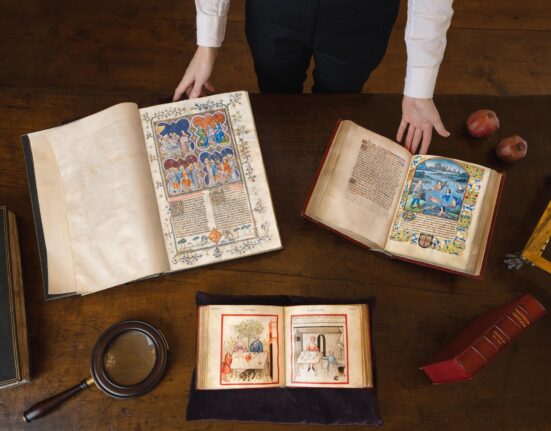MAASTRICHT, THE NETHERLANDS — The European Fine Art Fair, which closes Sunday, delivers a striking message. What is conventionally called the art market is a myth. There are as many micro-markets as there are categories in art and they do not follow the same patterns.
Consider “Antiquities,” a label that covers anything belonging to the Ancient World, from third-millennium B.C. Babylon to Rome in the third-century A.D. Taking in the significance of the art requires a high degree of cultural information. Buyers here, often driven by passion, are prone to disregard untoward economic circumstances.
At the Tefaf private viewing on March 15, an Egyptian limestone relief carved with the head of Queen Hatshepsut was promptly acquired on the stand of Rupert Wace. The London dealer’s asking price, €400,000, or $530,000, was not a problem. The likeness of the 15th-century B.C. queen depicted in the guise of a male pharaoh once formed part of a wall in her famous funerary abode at Deyr al-Bahri, and a U.S. couple of collectors owned the rarity by the early 1900s, thereby making it a legitimate acquisition, according to Unesco criteria.
That same evening, Mr. Wace’s Etruscan diadem convinced the British owner of the Mougins Museum of Classical Art, which opened its doors in southern France in June 2010, to settle a bill exceeding €100,000. The gold wreath appeared at an Ars Antiqua auction in Lucerne, Switzerland, on May 2, 1959, well before 1970, the year after which the purchase of objects recovered from underground caches ceases to be legitimate by Unesco standards.
Sculpture, which has been rising year after year, generally did well here.
Philippe Perrin, the Paris specialist in 18th- and 19th-century decorative art, parted at the private viewing with the terra-cotta figure of a young woman inscribed with the famous name Clodion, as the 18th-century Claude Michel signed himself. The €200,000 asking price posed no difficulty. A museum curator wanted it but missed the morning March 16 appointment where he was due to finalize the purchase. A collector snatched it by lunchtime.
It may take longer for the true sensation in the same line on Mr. Perrin’s stand to find a taker. Two allegories of Victory were carved in terra cotta by Jean-Claude Moitte as models for marbles destined for the Hôtel de Salm, now the Palais de la Légion d’Honneur in Paris. In place by 1791, they later vanished. The terra-cottas, important to art history, are natural targets for institutions. But at €850,000 making a decision will require some deliberation.
Monumental sculpture of a higher order is avidly sought after. Add an Expressionist flavor and it sells instantly.
At the private viewing, Daniel Katz of London sold a wooden head of Jesus with an intensely dramatic expression carved around the late 15th century, possibly in Flanders. The asking price, £75,000, or $120,000, allowed a speedy conclusion. The €160,000 head of a screaming man molded around 1836 by François Rude also went quickly. The plaster working model was used for one of the marble characters in “The Departure of the Volunteers” — aka “La Marseillaise” — on the Arc de Triomphe in Paris. Its place in art history guaranteed its easy sale.
Two smiling figures, originally conceived in 1857 and 1863 by Jean-Baptiste Carpeaux, were carved in marble in 1873. Signed and dated, they were included that same year in the historic Carpeaux sale held at the Hôtel Drouot. That made the €2.6 million pair irresistible.
History was a selling point in every field at the private viewing.
A painting by Maurice Denis done around 1891, “The Fairies,” hung on the Galerie Berès stand, which was otherwise essentially devoted to post-World War II art. Featured in the 2004-2005 show “Gauguin and the Origins of Symbolism” at the Thyssen-Bornemisza Museum in Madrid, the dramatic scene was among the first pictures picked up at the opening. Works by Leopold Survage, Simon Hantai and others followed.
A different pace characterized sales of 20th-century art. Activity was brisk at the lower financial levels. Two days into the fair, Patrick Derom, the Brussels dealer in 19th- and 20th-century art, had already sold several works, including a €100,000 abstract composition by Sonia Delaunay. By contrast, a stunning minimalist landscape done in India ink, wash and crayon by Léon Spilliaert, titled “The Beach” and dated 1907, was still under consideration as of Thursday — at €450,000.
Howard Shaw, president of Hammer Galleries in New York, who came in force with works by Léger, Picasso and Calder, said the mood at the fair was optimistic. But multimillion dollar level transactions would probably materialize over weeks.
By March 18, on stands focusing on 20th-century art, there were few of those red dots signifying that a deal had been clinched. Some dealers may postpone the finalization of sales until the fair is over to avoid the European Union tax on art sales, but that only partly explains the slow progress. As ever in the market, there were exceptions, like Van de Weghe Fine Art, which had already scored satisfactorily.
In Old Masters, where fast dwindling supplies generate a fear of missing out on major works, transactions were markedly speedier.
A telling sign of the last chance syndrome is the ease with which works widely acknowledged as the top of the top have been selling even when they are known to have been recently acquired at auction.
Johnny Van Haeften is loath to disclose sales and I saw no red dots on the English dealer’s stand, but he spoke enthusiastically about the excellent atmosphere. His “Mankind’s Eternal Dilemna: The Choice between Vice and Virtue,” a monumental composition by Frans Francken the Younger, reportedly priced around €14 million, is believed to have found a taker at the private viewing. Signed and dated 1633, the picture by the Antwerp master was a gift from that city to Peter Joseph von Franken-Siersdorf, a bishop of Antwerp who died in 1727, and remained in the hands of his descendants until recently. A technical tour de force, the picture ensconced in history was much admired by specialists.
William Noortman, based in Amsterdam, grinned as he said that he sold to an East Coast collector a still life of peaches painted by Adriaen Coorte in the early 1690s. Mr. Noortman, who acquired it at Bonhams last month, said he could have sold it several times despite a €3.2 million asking price. A €4.8 million still life by Jan van Huysum also bought at auction will likewise travel to the United States.
Paintings of great charm, if not of stellar importance, were pounced upon. A €350,000 Hubert Robert view of a ruined Roman construction was sold by Roman Herzig at the opening on March 17. The owner of the Galerie Saint Lucas in Vienna shares Mr. Noortman’s optimism about the market.
By contrast, extremely important works that are not carried by the tide of fashion like Dutch masters or, in a lighter vein, Hubert Robert, were not yet sold but were under consideration by institutions when I left the fair.
Coll & Cortés of Madrid display a “Saint Roch” by Murillo, exceptionally well preserved. The 17th-century Spanish picture once belonged to the connoisseur Cármine Nicolás Caracciòlo, prince of Santo-Buono, who died in 1727, and was in the collection the duke of Alba by 1828. The superlative museum picture should soon find its way into an institution.
Perhaps the most important news is that China’s economic slowdown is not quelling the rush on art by its citizens. Gisèle Croës of Brussels sold her greatest Chinese bronzes to collectors from mainland China. On March 20 a collector from Beijing paid $2.5 million for a monumental two-handled vessel of the sixth- or fifth-century B.C. Ms. Croës said that it was the first time mainland buyers had bought major works on her stand at the Tefaf. But a superb silver and gold inlaid bronze clasp in the shape of a rhinoceros with a $600,000 price tag went to a New York collector. Never was the financial muscle of China so clearly felt at a European fair.
If proof was needed that the multiple micro-art markets do not follow the curve of the broader economy, this is it.







